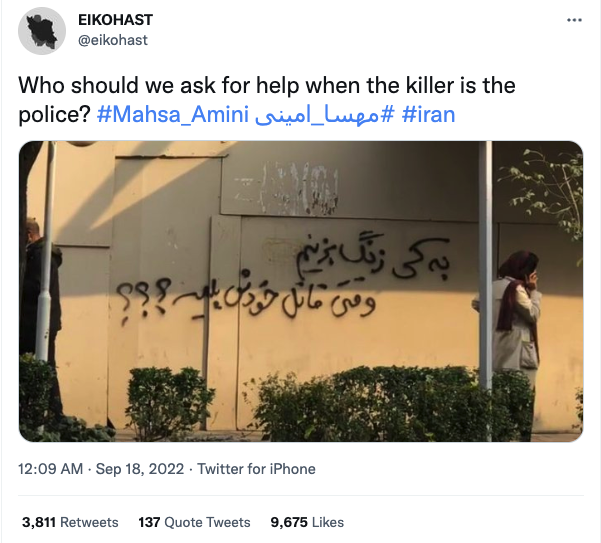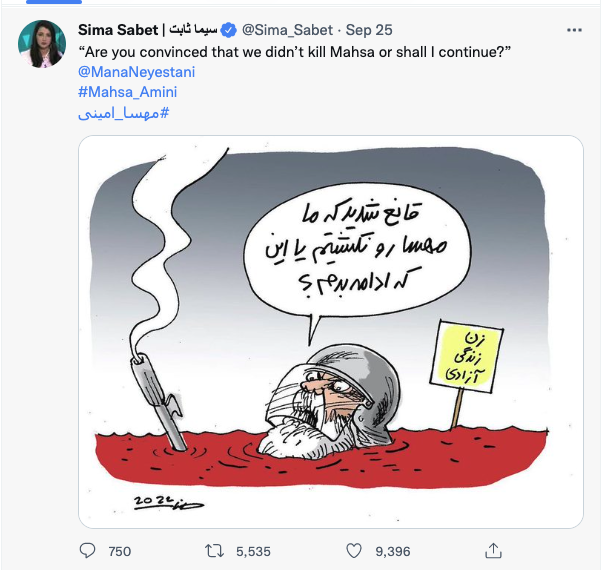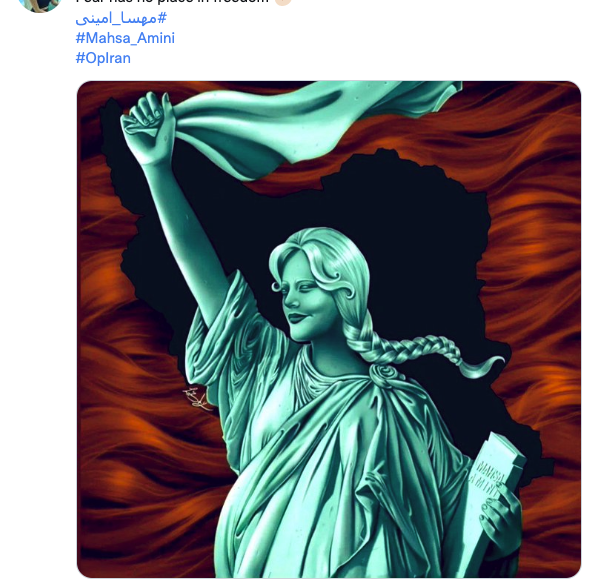Iranians have been protesting throughout the country this past week in response to the death of Mahsa Amini, a 22-year-old Kurdish woman who was killed after being detained for an “improper dress” by the country’s morality police. Officials claim she died of a heart attack but eyewitnesses and medical scans show skull fractures from head trauma.
Amini’s death has brought the issue of unjust killings of Iranian youth and ethnic and religious minorities to the forefront of international headlines. To show support for the protestors and human rights in Iran, in his address to the UN General Assembly last week, President Joe Biden stated: “And today, we stand with the brave citizens and the brave women of Iran who right now are demonstrating to secure their basic rights.”
The collective rejection of the veil serves as a great unifier and helps protestors feel they are not alone in resisting the government’s unjust laws and practices.
Iranian citizens have once again captivated a global audience with their tenacity and strength in the face of widespread government repression. After the harsh suppression of the 2009 Green Movement, social movements in the country were temporarily suppressed. Despite government crackdowns, widespread protests took place in 2017 surrounding the arrest of Vida Movahed for standing defiantly on an electrical box, removing her headscarf, and placing it on a stick. Images of Movahed’s dissent went viral and inspired others to mobilize and take action. In 2019, Iranians took to the streets following the death of Sahar Khodayari and commemorated her with #bluegirl after the color of her favorite Iranian football team. That same year, widespread public protests took place again after a sharp rise in gas prices that led the government to initiate a nearly one-week internet shutdown.
This cycle of resistance and repression tends to repeat itself, as seen by the shutdown of Instagram and WhatsApp in the wake of the most recent round of protests. While mandatory dress codes have been enforced in Iran since the country’s 1979 revolution, how strictly these laws are enforced by officials tends to ebb and flow. Over four decades of enforcing an Islamic dress code, Iranian citizens have become accustomed to these shifts in enforcing regulations and respond accordingly. Through field research, I have observed that when officials are cracking down, Iranian youth tend to follow the rules more, when crackdowns have settled down, they begin to be more liberal with their dress.
Since the election of Iran’s new President Ebrahim Raisi last year, the government has started to strictly enforce these laws on morality/public appearance and conduct, placing pressure on a youth population that is already disenchanted by a rising cost of living and high unemployment rates.
IRANIANS’ DIGITAL ACTIVISM
The death of Amini contributed to some of the most active days on Farsi Twitter in years. My colleague Steven Wilson and I have been collecting all Farsi language tweets since 2019 through Twitter’s Application Programming Interface (API) by using parameters such as Farsi characters and stopwords. On Sept. 21, 2022 we observed nearly 4 million tweets from 280K distinct users. On Sept. 22, 2022 we observed the largest spike in Farsi language tweets since we began our collection three years ago.*
Through analysis of Farsi language tweets and tweets collected based on key terms using Amini’s name, we see a clear spike in the number of Farsi language tweets in the days leading up to and following her death. Online and street protests/activism occurred simultaneously and arguably fueled each other in a call to action. Tweets mentioning Amini also skyrocketed after news of her death was released. For example, 723,720 tweets mentioned #Mahsa_Amini on Sept. 20, 2022 and on Sept. 21, 2022, 659,878 tweets contained the hashtag. To give you a sense of scale, these numbers on one very specific hashtag are equivalent to what we would normally see on all of Persian Twitter in one day.**
The content of these tweets ranges from those expressing discontent, such as one post depicting an image of a wall scribbled in black graffiti stating “Who should we ask for help when the killer is the police? #Mahsa_Amini #مهسا_امینی #iran” to positive messages of support and encouragement, such as one tweet where a user states “who got the power? We got the power” accompanied by a collage of protest images.




THE IRANIAN WOMEN’S MOVEMENT MARCHES ON
The overlap between street protests and digital activism demonstrates the power of social media. Images from Twitter and Facebook have gone viral, and have held the attention of the international community. They have also helped legitimize calls for actions by Iranians activists, human rights defenders, and women’s rights supporters.
This rapidly rising movement to protest gender discrimination is a continuation of the ongoing Iranian women’s movement. The same acts of resistance — women removing and burning their hijabs, cutting their hair, and protesting in public — are all powerful and long standing tactics of Iranian social movements that have proven extremely effective at garnering attention and support both domestically and around the world.
While the aims of the women’s movement includes (but is certainly not limited to) the veil or mandatory Islamic dress, the head scarf (hijab) or veil has become a powerful symbol used to advocate for women’s rights and, more generally, human rights and social justice. The collective rejection of the veil serves as a great unifier and helps protestors feel they are not alone in resisting the government’s unjust laws and practices. This sense of solidarity is demonstrated through a common slogan chanted at street protests: “Don’t be afraid, we’re all together.”
Based on Farsi Twitter data collected from Sept. 15 to Sept. 21, 2022, including the number of tweets they show up in, the term “Mahsa Amini” (and other variations of her name such as #Mahsa_Amini, MahsaAmini, Mahsa_Amini) represent 45% of the top 15 hashtags used on Farsi Twitter during this time period. The top tweets also mention the names of other unjustly killed Iranian youth, such as Amirhossein Khademi, a 16-year-old boy who was found dead in a desert earlier this month after he was raped by his employer.
There has also been overlap and support for the Iranian women’s movement from many other social justice movements around the world, including activists from Black Lives Matter, where the hashtag #IranianLivesMatter is now trending on Farsi Twitter. With protests in over 80 cities throughout the country being documented and discussed on social media, the most recent wave of public resistance in the country represents a continuation of the strong history of activism in Iran.
The movement to protect against human rights abuses and discriminatory laws is also gaining external interest and support, as anonymous users around the globe recently launched #opiran, another top trending term/hashtag, to take over thousands of CCTVs in the country. These offshoots/related discussions demonstrate how Iranian activists have successfully garnered support both at home and abroad, and are able to mobilize networks across borders.
*The high volume of tweets caused Twitter to rate limit our stream, which is a strategy to limit network traffic and stop malicious actions like bot activity.
**The hashtag was collected in English. Thus, the comparison to Farsi Twitter is based on numbers and does not necessarily represent an overlap in content.




















